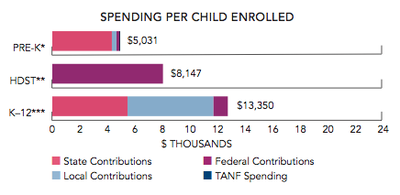By
[Posted on Education Week’s Early Years Blog on May 12, 2016]
Total spending on public preschool has surpassed pre-recession levels for the first time since the 2008 downturn, adjusting for inflation, according to the latest data release from the National Institute for Early Education Research (NIEER), a think tank in New Jersey focused on early education.
 The 42 states with public preschool programs and the District of Columbia spent $6.2 billion to serve 1.4 million 3- and 4-year-olds in the 2014-15 school year. Total enrollment increased by a single percentage point, from 28 percent to 29 percent of 4-year-olds and from 4 percent to 5 percent of 3-year-olds, since 2010.
The 42 states with public preschool programs and the District of Columbia spent $6.2 billion to serve 1.4 million 3- and 4-year-olds in the 2014-15 school year. Total enrollment increased by a single percentage point, from 28 percent to 29 percent of 4-year-olds and from 4 percent to 5 percent of 3-year-olds, since 2010.
“This year’s rate of progress is not enough to bring high quality pre-K to every child any time soon,” the report concludes.
Some states are making big strides, though. New York City’s new universal preschool program for 4-year-olds had a notable impact on this year’s findings. The city alone enrolled more than 12,000 additional children in preschool in 2014-15. Including enrollment increases outside New York City, the state accounted for two-thirds of the national spending increase and enrolled 5 percent more children in 2014-15 than in 2013-14.
 The District of Columbia, Florida, Oklahoma, Vermont, and West Virginia lead the country in preschool access for 4-year-olds. Idaho, Montana, New Hampshire, North Dakota, South Dakota, Utah, and Wyoming continue to not have a state preschool program, though several of these states do have local, district-based programs.
The District of Columbia, Florida, Oklahoma, Vermont, and West Virginia lead the country in preschool access for 4-year-olds. Idaho, Montana, New Hampshire, North Dakota, South Dakota, Utah, and Wyoming continue to not have a state preschool program, though several of these states do have local, district-based programs.
Hawaii and Mississippi have new preschool programs that were counted for the first time in the 2015 NIEER report. Indiana also started a pilot program that NIEER researchers considered too small to include, according to the report.
Even as enrollment and spending increased overall, some states spent less in 2014-15 than in 2013-14. Arkansas, Connecticut, and Texas all spent nearly $1,000 less per child, according to the report. Fifteen other states also dropped spending by anywhere from $17 to $649 per child.
Meanwhile, Florida and Texas continue to have some of the lowest-quality standards in the country while enrolling a huge number of children in their state preschool programs. Florida, for example, which spends $2,300 per child (ranking 39th among the states) and meets only three of NIEER’s 10 basic measures of program quality.
 California is similar, though the situation is complicated there by the existence of transitional kindergarten, a high-quality, public school-based program for some 4-year-olds that is not included in the NIEER report.
California is similar, though the situation is complicated there by the existence of transitional kindergarten, a high-quality, public school-based program for some 4-year-olds that is not included in the NIEER report.
“By itself [California’s transitional kindergarten program] would add 77,274 children to the pre-K rolls, raising the national percentage served to 31 percent of 4-year-olds and adding $604 million to funding for a grand total of $6.8 billion nationally,” the report states.
For the first time this year, NIEER also reported on support for young dual-language learners and the early-education workforce. Broadly, only a few states track and actively support children who speak a language other than English at home. And preschool teachers nationally are paid nearly $12,000 less than elementary school teachers even when employed at public schools. For non-public school-based preschool teachers, the difference in salary is more like $27,000.
Both of these new measures help paint a more complete picture of preschool quality nationally. Despite bright spots, the picture is still fairly bleak, according to the report.
“Expansion of public pre-K is only a worthwhile public investment if children receive a high-quality education,” the report states. “Unfortunately, even many of the states that have chosen to fund pre-K have not committed sufficient resources to fund a high-quality program.”
Charts courtesy National Institute for Early Education Research.